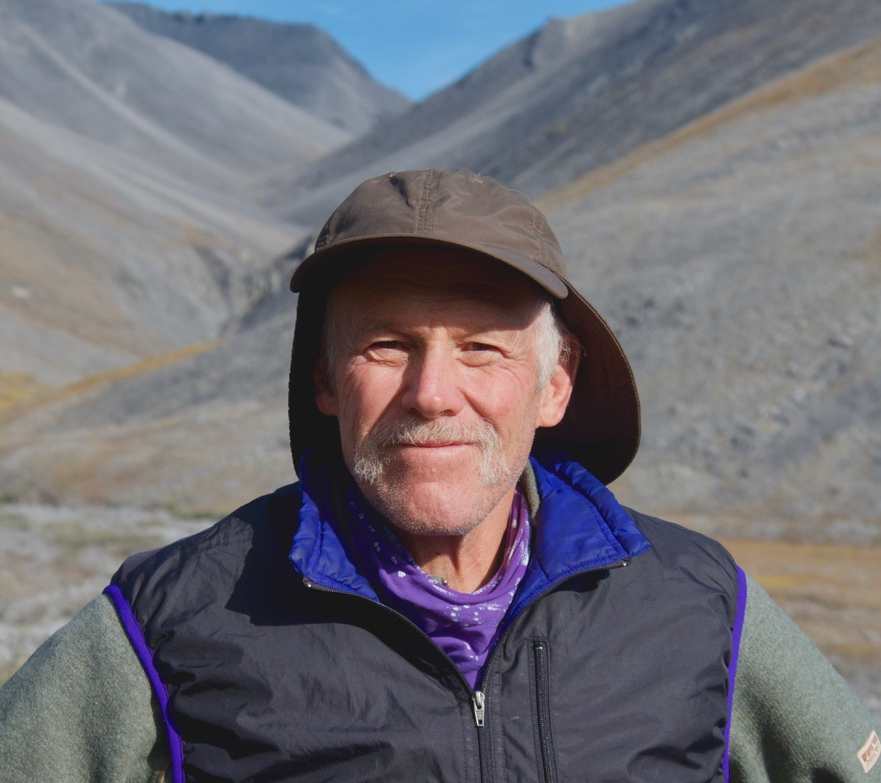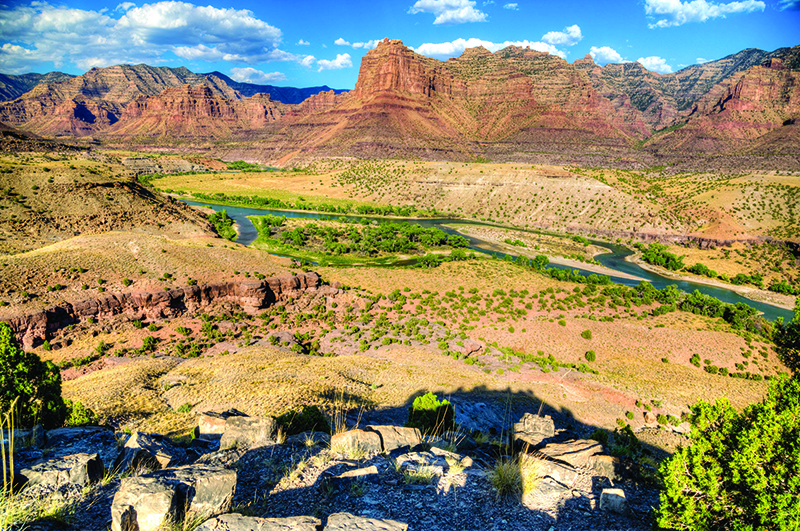Utah Wilderness: Keep it Wild!
by Howie Wolke

The Colorado Plateau of eastern and southern Utah is a unique landscape of colorful sedimentary rocks and mesas dissected by spectacular canyons of the Green and Colorado River systems. And, despite a long history of ranching, mining and the associated dirt road network fragmenting the outback, much of this spectacular realm remains roadless and wild.
In 2019, the John D. Dingel Conservation Act designated 17 new Wilderness areas in Utah’s canyon country, totaling 663,000 acres— a formidable accomplishment given Utah’s political culture. The bill also protected 3 segments of the Green River under the National Wild and Scenic Rivers Act. Fourteen of the new Wildernesses are within the rugged San Rafael Swell, which many consider to be a potential new national park. Two new Wildernesses are in the Desolation Canyon-Book Cliffs area, and the act also protected wildlands on the east side of the Green River in Labyrinth Canyon.
The 143,000-acre Desolation Canyon Wilderness is the largest new Wilderness. The Desolation Canyon country (“Deso”) is remarkable even by Utah standards. The Green River slices a 5,000-foot deep gorge through colorful layered sediments. But wilderness isn’t just about scenery. Deso harbors unusual habitat diversity, ranging from wetlands and riparian cottonwood forests to Colorado Plateau Desert of sagebrush and saltbush, to pinyonjuniper woodlands and even stands of Douglas-fir, true fir, spruce and aspen at the highest elevations. This habitat diversity, along with the area’s large size, supports unusually high biodiversity, especially for wildlife. The obvious critters are mule deer, elk, bison, black bear, bighorn sheep, coyote and mountain lion, but there are also midget faded rattlesnakes, tarantulas, ferruginous hawks, both eagle species, peregrine falcon, long-billed curlew, white-faced ibis plus wild turkey, lots of waterfowl, beaver and much more. There are 3 endangered fish species, in addition to the Green’s tasty catfish.
For us two-legged primates, Deso is known as one of the premiere wilderness float trips in North America, with over 100 miles of floatable wild river. In fact, a September 1982 80-mile Deso journey was my first of many ensuing wilderness river adventures.
The recently designated Wildernesses in Utah represent progress, yes, but it’s just a start. Take Deso, for instance. Its 143,000 acres of Wilderness along and adjacent to the west shore of the Green River represent much less than half of the roadless wildland. There are roughly 500,000 acres of contiguous BLM-administered lands that could be included in the Wilderness, including a gentle 30-mile section of the Green River upstream from the canyon, a rich habitat of riparian wetlands and high desert benches, known for its diverse avifauna including herons, ibises and waterfowl. The ecological values of this river section are particularly outstanding. Downstream, while the official Wilderness protects lands only in the southern end of the canyon on the west side of the river, 165,000 acres of Desolation Canyon’s east side are managed as wilderness by the Uintah and Ouray Indian Reservation. In fact, a holistic view of the Desolation Canyon country recognizes a roadless wildland of about 860,000 acres. Close a handful of “cherry-stemmed” dirt roads plus the four-wheel drive dirt road that separates Deso from the adjacent Turtle Canyon Wilderness, and the Desolation wildland grows to nearly a million unbroken acres!

In addition to incomplete designations, threats to the new Wilderness units and contiguous wildlands abound. In a region that did not evolve with large herds of hoofed mammals such as bison, cattle chomp the uplands, destroying fragile biotic crusts, and they pollute and physically demolish riparian habitats. Mining and oil/gas development threaten roadless lands adjacent to the Wilderness, and illegal off-road vehicle abusers—including mountain bikers—scar both the Wilderness and adjacent roadless areas. In addition, the BLM currently allows motors in both Desolation and Labyrinth Canyons. Backcountry airstrips are another insult.
Of course, the Bureau of Land Management (BLM) is often called the “Bureau of Livestock and Mining”, catering shamelessly to those two industries plus mechanized off-roaders. Recently, the agency initiated a planning process that lumps the Dingel Act’s new Wilderness areas together with developed BLM-administered multiple (ab) use lands. Instead, each Wilderness area or Wilderness cluster should merit its own wilderness stewardship plan. In the United States, Wilderness is the highest level of land protection, surpassing even that of national parks, unless the park includes designated Wilderness. Wilderness is the antithesis of civilization’s unrelenting quest to dam, pave, bulldoze, fence, graze, log, dig, drill, subdivide, mechanize, urbanize and otherwise fragment nature’s original landscape. Wilderness is nature’s original landscape, and as the growing human population continues to obliterate wild nature, wild nature will continue to become both harder to protect and more fundamentally important.
The preliminary scoping period for public comments on the BLM planning process ended in January. Remember, though, that we taxpayers employ federal agency personnel, including BLM employees. They work for us, not just for ranchers and miners! And by law, they must consider public comments, even outside of timelines delineated by a particular planning process. Here is a sample of what the BLM needs to hear:
As mentioned, the BLM should create area specific wilderness stewardship plans for each designated Wilderness or Wilderness cluster. For example, there should be one stewardship plan for Deso and the Turtle Canyon Wilderness plus the Green’s three designated wild and scenic river segments. Plans should clearly specify that Wilderness areas must be managed primarily to protect wilderness character—as the 1964 Wilderness Act mandates! Plans should also prioritize wildlife, native species and overall wildness rather than trying to mollify various user groups.
The BLM should also maintain the roadless/undeveloped character of unprotected roadless areas, and should recommend them for Wilderness designation.
In addition, vacant livestock allotments should be permanently closed, and the BLM should amend its resource management plans to curtail livestock grazing where it is damaging natural ecosystems, which is nearly everywhere in these arid environments. Then they should remove unnecessary grazing infrastructure. Motor boats are an insult to Desolation and Labyrinth Canyons and should be banned. So should aircraft landings in Wilderness. In fact, the BLM should eliminate all mechanized use of Wilderness and roadless potential wilderness within the planning area. And finally, closing off and reclaiming cherry-stemmed road intrusions would enlarge Wilderness, and create more defensible wilderness boundaries plus more ecologically functional Wilderness with less edge and more secure interior habitat.
Utah’s remaining wild canyon country is a gift. That much of it still remains wild is a function of luck, topography and the hard work of conservationists in Utah and elsewhere. Let’s give future generations of all creatures the enduring gift of perpetual wildness. For there is no greater quest than that to protect and restore truly wild wilderness.
------------------
Howie Wolke is a retired wilderness guide/outfitter from southern Montana near Yellowstone National Park. He is on the Wilderness Watch board of directors and has also served two terms as president of the organization. He lives with his wife Marilyn Olsen and their dog Rio in southern Montana near Yellowstone National Park.
Photo: Bob Wick, BLM
When you subscribe to the blog, we will send you an e-mail when there are new updates on the site so you wouldn't miss them.
Blog Categories
Contact Us
Wilderness Watch
P.O. Box 9175
Missoula, MT 59807
P: 406-542-2048
E: wild@wildernesswatch.org
Minneapolis, MN Office
2833 43rd Avenue South
Minneapolis, MN 55406
P: 612-201-9266
Moscow, ID Office
P.O. Box 9765
Moscow, ID 83843

Comments 63
I strongly agree that we need to leave nature and wild animals alone. They deserve to live out their lives free of harm in their natural habitats.
In the more populous states in the East and Midwest, counties and townships have zoning regulations that can put the brakes on urban sprawl and the conversion of farmland into housing developments, retail and industrial complexes. I wonder if there is a way to prevent such development in the wilderness areas of the West where most of the endangered species seem to live. I've read of housing developments directly abutting wilderness areas inhabited by bears, mountain lions, wolves, etc. Wildlife should be entitled to their unspoiled habitat just as humans do.
Two things:
—I agree with your comments, and I plan to write to the field offices in support of your views. However, it’s been my experience that field offices take their marching orders from their national office. Why did you not suggest writing to the national office?
—In response to one of your supporters, it appears that most wilderness areas are for hikers; if you’re in a wheelchair (as I am), you’re just out of luck. I’m afraid that adding some access for wheelchairs may affect, at least in part, the wildness of the wilderness.
Having been fortunate to experience Utah's redrock wilderness close up, I strongly support maximum protection.
Keep it wild....
Special and beautiful places should remain wild! Let's do all we can to protect these special lands.
It's always an endless fight and has been for decades but we must not give up.
I hope Utah stays beautiful and wild for people and wildlife.
We must stand up and take our positions with respect for the environment that
sustains us and will for future generations.
Thank you so much for caring about wilderness preservation and the environment. Keep up the good work, you've got a cast of millions behind you.
A most beautiful state, keep it that way and wild!
Please keep the wilderness as is!
Keep the area as wild as possible for future sightseers.
Keep the wildlife free and safe. Protect the wilderness.
My husband and I hope that we can return to Utah with our grandchildren and find it as wild and beautiful as it was in 1970.
Please pass and maintain laws to keep the wilderness wild.
Leave wild places wild like nature intended for them to be. Leave the wild things that call them home in peace and unmolested. Peace and Ecology Now!
Utah has an abundant land mass beautiful and teaming with wildlife that should be preserved as a national treasure and reserve for plant and animal biodiversity. Please leave these pristine lands untouched for the future of this Country's legacy and contribution to hopeful reversal of climate catastrophe. Thank you for your valuable time and attention.
The Colorado Plateau of eastern and southern Utah is a unique landscape of colorful sedimentary rocks and mesas dissected by spectacular canyons of the Green and Colorado River systems. And, despite a long history of ranching, mining and the associated dirt road network fragmenting the outback, much of this spectacular realm remains roadless and wild.
Deso harbors unusual habitat diversity, ranging from wetlands and riparian cottonwood forests to Colorado Plateau Desert of sagebrush and saltbush, to pinyon-juniper woodlands and even stands of Douglas-fir, true fir, spruce and aspen at the highest elevations. This habitat diversity, along with the area’s large size, supports unusually high biodiversity, especially for wildlife. The obvious critters are mule deer, elk, bison, black bear, bighorn sheep, coyote and mountain lion, but there are also midget faded rattlesnakes, tarantulas, ferruginous hawks, both eagle species, peregrine falcon, long-billed curlew, white-faced ibis, plus wild turkey, lots of waterfowl, beaver and much more. There are 3 endangered fish species, in addition to the Green’s tasty catfish.
We need more of this type of good work protecting our wilderness.
Thank you for the wonderful work you're doing! Much appreciated!